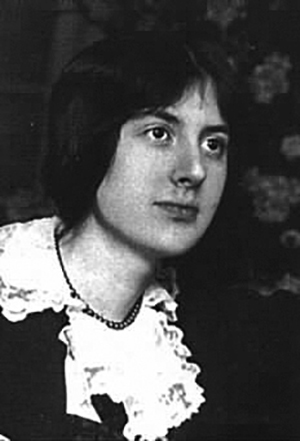
About the Piece
Instrumentation: Full Orchestra
3 (2flu, pic) 3 (2ob, EH) 3 (2cl, Bass-Cl) 3 (2bn, sarrusophone or contra bassoon), 4331, 2perc, hp, celeste, strings
Duration: 6 min
Program Note:
D’un matin de printemps had a complicated history. Lili Boulanger began work on it in the spring of 1917 as a piece for violin and piano (or optionally flute and piano), then made another setting for piano trio, and finally created the version for orchestra performed in this concert. The various versions do not align exactly. Lili did not intend for any of these settings to supersede the others; instead, she viewed them as parallel, slightly different takes on the same basic conception. All of the surviving manuscripts are in the hand of Nadia, who effected some refinements particularly on the orchestral version, which seems to have been completed in January 1918.
This does not sound at all like a deathbed piece. The piece is a work of vibrant energy and surpassing delicacy, strikingly in mode of the French “Impressionist” composers—or, at places, of Spanish composers (like Falla) who were similarly inspired by them. Boulanger makes colorful use of her wind sections, typically a strength of French composers. It captures the listener from the very outset, where the good-spirited principal theme is introduced by solo flute playing in its low register against lightly rustling strings and shimmering touches of triangle and celesta. The theme is passed around from instrument to instrument, as is the accompanying figure, and the music soon sinks to the orchestra’s lower reaches, losing its propulsive energy and taking on a gauzy quality, almost as if it were underwater. From there, the music again rises in a crescendo for the full orchestra. Suddenly the texture thins to chamber-like combinations—a passage not unreminiscent of Mahler’s Das Lied von der Erde, a work with which Nadia was familiar, and probably Lili along with her. The work’s ending is stunning: a buildup of volume and energy, a precipitously descending harp glissando, and a final pop from the orchestra. —James M. Keller
Conductor’s Perspective
A great short piece in the style of Debussy, really effective. The orchestra is large and has its challenges — It might not be technically too difficult for experienced student orchestras, but would take quite some rehearsal time for them to understand the fast shifting of orchestral colors and textures. It’s also challenging for wind intonation, with solo passages doubling flute and oboe/clarinet OR piccolo and bassoon, for example.
This can be performed as a set with Boulanger’s D’un Soir Triste or alone. This is the harder one of the two.
About the Composer
Lili Boulanger was a French composer and the younger sister of the noted composer and composition teacher Nadia Boulanger.
A Parisian-born child prodigy, Boulanger’s talent was apparent at the age of two, when Gabriel Fauré, a friend of the family and later one of Boulanger’s teachers, discovered she had perfect pitch. Her parents, both of whom were musicians, encouraged their daughter’s musical education. Her father was 77 years old when Lili was born and she became very attached to him. Her mother, Raissa Myshetskaya (Mischetzky), was a Russian princess who married her Paris Conservatoire teacher, Ernest Boulanger. Her grandfather Frédéric Boulanger had been a noted cellist and her grandmother Juliette a singer. Boulanger accompanied her ten-year-old sister Nadia to classes at the Paris Conservatoire before she was five, shortly thereafter sitting in on classes on music theoryand studying organ with Louis Vierne. She also sang and played piano, violin, cello and harp.
In 1912 Boulanger competed in the Prix de Rome but during her performance she collapsed from illness. She returned in 1913 at the age of 19 to win the composition prize for her Faust et Hélène, becoming the first woman composer to win the prize. Nadia had given up entering after four unsuccessful attempts and had focused her efforts upon her sister Lili, first a student of Nadia and then of Paul Vidal, Georges Caussade and Gabriel Fauré–the last of whom was greatly impressed by the young woman’s talents and frequently brought songs for her to read. Lili was greatly affected by the 1900 death of her father; many of her works touch on themes of grief and loss. Her work was noted for its colorful harmony and instrumentation and skillful text setting. Aspects of Fauré and Claude Debussy can be seen in her compositions, and Arthur Honegger was influenced by her innovative work.
(taken from the Philadelphia Chamber Music Society)
Performance Materials
● The Durand score has many mistakes and the rental request needs to be done either on the Durand website, or through Zinfonia search.
DURAND Version Perusal Score Sample (click for link)
● The Fleisher Collection of Orchestra Music (as part of the Free Library of Philadelphia) has published a new set, edited by Clinton F Nieweg). The set is available for rent through the Fleisher Collection. The cost is rather affordable (less than $100 in 2019) with some shipping and handling fee.
Contact:
Stuart Serio, Assistant Curator
Fleisher Collection of Orchestral Music
Free Library of Philadelphia
1901 Vine St
Philadelphia PA 19103-1116
215-686-5313 tel
serios@freelibrary.org
● Perusal Score Samples
Recording
Recording on YouTube by the Chicago Youth Symphony Orchestra